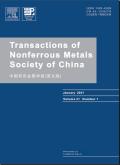Leaching of WO3 from sulfuric acid converted product of scheelite in NH3·H2O−NH4HCO3 solution
IF 4.7
1区 材料科学
Q1 METALLURGY & METALLURGICAL ENGINEERING
Transactions of Nonferrous Metals Society of China
Pub Date : 2025-01-01
DOI:10.1016/S1003-6326(24)66682-3
引用次数: 0
Abstract
The leaching of sulfuric acid converted product of scheelite in NH3·H2O−NH4HCO3 solution was systemically studied to improve sulfuric acid conversion−ammonium salts leaching technology route for ammonium paratungstate production. The results showed that the WO3 leaching efficiency was about 99% under optimal conditions of 350 r/min, liquid-to-solid ratio of 3 mL/g, 1 mol/L NH4HCO3, 4 mol/L NH3·H2O, 25 °C, and 15 min. During the leaching, CaSO4 almost had no change and was still in a banding or rod-like shape in short leaching time, while conglobate CaCO3 was gradually formed on the CaSO4 surface. A secondary reaction might occur between CaSO4 and WO42−, which could be restrained by a certain amount of CO32− in the solution. There was no CaCO3 phase determined by XRD in leaching residue of converted product for scheelite concentrate under optimal conditions, which was different from that for synthetic scheelite. The leaching process could be explained by neutralization reaction of H2WO4 and solid transformation of CaSO4 in NH3·H2O−NH4HCO3 solution.
求助全文
约1分钟内获得全文
求助全文
来源期刊
CiteScore
7.40
自引率
17.80%
发文量
8456
审稿时长
3.6 months
期刊介绍:
The Transactions of Nonferrous Metals Society of China (Trans. Nonferrous Met. Soc. China), founded in 1991 and sponsored by The Nonferrous Metals Society of China, is published monthly now and mainly contains reports of original research which reflect the new progresses in the field of nonferrous metals science and technology, including mineral processing, extraction metallurgy, metallic materials and heat treatments, metal working, physical metallurgy, powder metallurgy, with the emphasis on fundamental science. It is the unique preeminent publication in English for scientists, engineers, under/post-graduates on the field of nonferrous metals industry. This journal is covered by many famous abstract/index systems and databases such as SCI Expanded, Ei Compendex Plus, INSPEC, CA, METADEX, AJ and JICST.

 求助内容:
求助内容: 应助结果提醒方式:
应助结果提醒方式:


